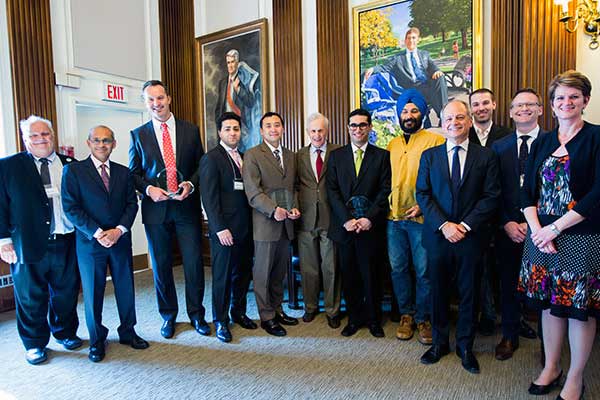
From 3D printing for kids to spine surgery tools: U of T celebrates its top innovators
Published: May 13, 2015
The spirit of innovation and invention at U of T soared on May 7, when the University of Toronto paid tribute to researchers and students who have made their mark with a host of technologies and successful startup companies.
“The University of Toronto’s long history and acclaimed reputation as an institution is well known,” said President Meric Gertler to guests at U of T Celebrates Innovation. “Lesser known, I would suggest, is our role as a leading innovation and startup powerhouse.”
Gertler pointed out that over the past decade, U of T has become one of the fastest-growing entrepreneurial clusters on the continent and that, since 2010, no single university has helped create more startup companies than U of T and its partner hospitals.
“Simply put,” he added, “we are on an extraordinary trajectory and for this we can credit the distinguished individuals gathered here.”
Professor Vivek Goel, U of T’s vice-president, research and innovation, said U of T has made significant progress in the innovation area in the past few years.
“Our improvement has a number of benefits. It strengthens U of T’s international reputation, it is involving students at a greater pace than ever before, and our innovations have a positive impact on people’s lives.”
The 2015 Inventors of the Year are:
- Parham Aarabi, electrical and computing engineering, who invented the Extended Touch User Interface. This technology enables any flat surface to become tap sensitive by placing a mobile device on it.
- Richard Cobbold, Institute of Biomaterials and Biomedical Engineering and U of T alumnus Dr. Amir Manbachi of Spinesonics Medical Inc, who invented the PedicProbe. This technology consists of an imaging array at the end of a surgical drill kit. The device uses ultrasound technology to give surgeons a clearer picture during operations where screws are inserted into the spine.
- Hugh Liu, U of T Institute for Aerospace Studies, who invented the System for Generic Synchronized Motion Control. It provides a generic synchronized motion control system for multiple dynamic systems. It has the potential for a wide range of applications. One project made a successful field flight demonstration using ‘unmanned aerial vehicles’ for wildfire monitoring.
- Karan Singh, computer science and Dr. James McCrae, post-doctoral fellow, who invented flatfab and True2Form. Flatfab is software aimed at subtractive manufacturing in natural materials like wood to complement the new area of additive manufacturing (3D printing). It is was created for non-professionals, such as hobbyists and children, to create compelling 3D objects. It has been tested and used as a design tool by students at John Paul II Catholic Secondary School in London, ON. True2Form improves the productivity of design professionals, enabling them to sketch in 2D freely and have their creations automatically transformed into 3D digital models.
- Igor Stagljar, Donnelly Centre for Cellular and Biomolecular Research, department of biochemistry, department of molecular genetics and Dr. Julie Petschnigg, who invented Mammalian membrane two-hybrid (MaMTH), which tracks a class of proteins called membrane proteins as they interact with other proteins to either maintain or contribute to health. These proteins are associated with more than 500 diseases. This technology provides a new tool to examine membrane proteins in their natural environment of the human cell. It is sensitive enough to detect minor changes upon the introduction of drugs and thus should prove useful in the development of therapeutics, especially for cancer and neurological diseases.
To qualify for an inventor of the year award, entrants must be faculty members or trainees who disclosed their inventions to U of T’s Innovations and Partnerships Office within the past five years. Inventions are assessed based on their uniqueness, potential for global impact and commercial appeal.
Also honoured at the event were five companies that participated in the University of Toronto Early-Stage Technology Program (UTEST) and nine faculty members who received the Connaught Innovation Award, which accelerates the development of promising technologies. (Read more about the winning companies and projects.)



